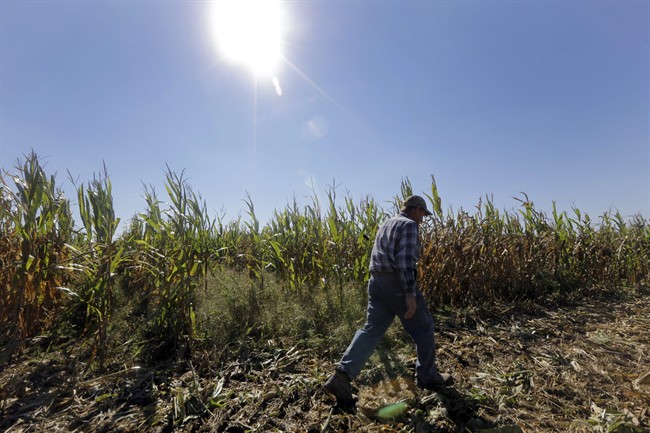Banning neonics will have a minimal effect on corn and soybean yields, an internal federal government draft report shows.

Neonicotinoids, a class of pesticides, are widely suspected of contributing to bee losses as high as 58 per cent in Ontario. In response, Ontario is enacting a partial ban on neonics and is facing stiff resistance from grain farmers and the pesticide lobby. The draft regulation is currently open for public comment until May 7. If approved, the new rules will take effect July 1, 2015.
Ontario’s proposed partial ban comes after the European Union passed a two year moratorium which effectively banned neonics at the beginning of last year.
The internal government draft report, obtained exclusively by 16×9, estimates that a ban on neonics could mean up to a $91.3 million net loss in revenue for farmers, out of a total $4.69 billion, or 1.9 per cent.
“This study should go some way to assure politicians that a huge financial hit will not happen,” as a result of a partial ban in Ontario says Dave Goulson, a bee expert and professor of biology at the University of Essex in the United Kingdom. “There are not going to be catastrophic losses because of this.”
The Health Canada Pest Management Regulatory Agency (PMRA) report suggests that soy farmers could experience a net economic loss of 0.4 per cent and corn farmers could face a 3.6 per cent loss if neonics were banned across Canada.
For soy yields the PMRA says that analyses “are consistent with that reported by the U.S. Environmental Protection Agency.” The U.S. EPA reported “that in most cases there is no difference in soybean yield when soybean seed was treated with neonicotinoids versus not receiving any insect control treatment.”
BELOW: EPA Memo – Benefits of Neonicotinoid Seed Treatments to Soybean Production
“There is not much point in using neonics for soybeans,” Goulson says, but he admits that for corn the issue is more nuanced. “Some farmers may suffer and we should not be dismissive about their losses.” Goulson’s science concluded neonics hurt bees and is a strong advocate of the European ban. He says that in places with a lot of pest pressure corn farmers might want to consider “more crop rotation and diversifying their crop.”
In 16×9’s most recent investigation on neonicitinoids, Pierre Petelle of pesticide lobby group, CropLife Canada told 16×9, “There are hundreds of studies that show that field conditions where bees are being exposed to these products… are at such low levels that they are not having impacts on colonies.”
But science is now suggesting neonics are killing more than just bees. “It is a neurotoxin designed to kill insects. That is what it is. So we should not be surprised that it kills bees and butterflies and other insects. That is what it’s designed to do,” says Gord Miller, the Environmental Commissioner of Ontario, the province’s independent environmental watchdog who is appointed by the Legislative Assembly. He has reviewed the science on neonics and says they could be affecting other creatures, including butterflies, fish, aquatic insects and birds.
FULL EPISODE: 16×9‘s ‘Season of Change’
While the draft report estimates a ban on neonics in Ontario may only have an $85 million impact, industry numbers published by the Conference Board of Canada are much higher. The group estimates farmers could lose up to $325 million in net income and the Ontario economy could lose $630 million in revenues.
BELOW: The Conference Board of Canada – The Value of Seed Treatment for Ontario Growers
The draft report obtained by 16×9 has a murky history. In 2013, the PMRA targeted to complete the results of this study by 2014. 16×9 obtained a correspondence sent out from the PMRA to provincial officials stating the value assessment was ready for publication in early March and would be put to public comment for a 45-day period. It’s now been more than two months since that correspondence was sent.
The federal government has been accused in the past of foot dragging when it came to tighter regulations, a stance which has effectively favoured the pesticide industry.
16×9 reached out to the PMRA for an interview. In an email the agency said, “Health Canada continues to assess the value of the corn and soybean neonicotionoid seed treatments as part of the re-evaluation of these insecticides and the assessment is not complete.” PMRA went on to say, “once complete, Health Canada will post the value assessment for public consultation.”
The draft report obtained by 16×9 says the results are preliminary and the PMRA is “seeking additional information.” The PMRA told 16×9 “Health Canada and the U.S. Environmental Protection Agency are working together on a pesticide re-evaluation process for three neonicotinoid pesticides (imidacloprid, thiamethoxam, and clothianidin)” and an interim progress report is expected this year while the entire assessment will be completed in 2017.


Comments